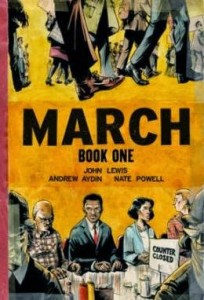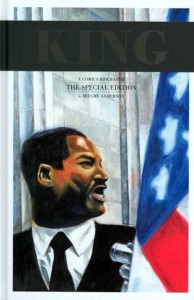As we recognize Martin Luther King, Jr., and celebrate his legacy today, one way we can explore his contributions to civil rights is by reading comics. Whether you’re a comics fan looking for a way to learn more about Dr. King or a teacher looking for books to use in your classroom, there are graphic novels that offer first hand accounts of the Civil Rights Movement, biographies of Dr. King, and accounts of events leading up to and during Dr. King’s protests for the rights of Black Americans.
We’ve covered a few of these graphic novels in our Using Graphic Novels in Education column, an ongoing feature from CBLDF that is designed to allay confusion around the content of graphic novels and to help parents and teachers raise readers. In this column, we examine graphic novels, including those that have been targeted by censors, and provide teaching and discussion suggestions for the use of such books in classrooms. To view more of the books we have covered, visit https://cbldf.org/librarian-tools/using-graphic-novels-in-education/
 Using Graphic Novels in Education: March: Book One
Using Graphic Novels in Education: March: Book One
March: Book One begins the trilogy of Representative John Lewis’s graphic novel memoir, co-written with his aide Andrew Aydin and illustrated by Nate Powell. March: Book One recounts Congressman Lewis’ youth in rural Alabama and a first-hand account of what life was like for Black families in the 1940s and 1950s under Jim Crow and segregation laws, as well as Lewis’s work alongside Martin Luther King, Jr., during the early years of the Civil Right Movement. It is a critically acclaimed best-seller that received the 2013 Coretta Scott King Honor Book Award by the American Library Association and was named one of the best books of 2013 by USA Today, The Washington Post, Publishers Weekly, Library Journal, School Library Journal, Kirkus Reviews, The Horn Book, Comics Alliance, and others. Read the full post
 Using Graphic Novels In Education: March: Book Two
Using Graphic Novels In Education: March: Book Two
March: Book Two is the second volume of Representative John Lewis’s graphic novel memoire, co-written with his aide Andrew Aydin and illustrated by Nate Powell. March: Book Two details the real-life heroes of the 1960s, from the Civil Rights leaders of SNCC and the SCLC to the black and white protesters who risked life and limb for what was right. In March: Book Two, Lewis’s story continues with the events that took place on November 10, 1960, in Nashville, Tennessee, as “…our young organization had successfully ended segregation at the lunch counters downtown and turned its attention to fast food restaurants and cafeterias using the same strategy.” It then continues with events that took place in the South between 1960 -1963, culminating with the March on Washington on August 28, 1963. Read the full post
 Using Graphic Novels in Education: King
Using Graphic Novels in Education: King
King by Ho Che Anderson (Fantagraphics, 1993; reprint edition 2010) is a highly acclaimed award-winning biography integrates interviews, narrative, sketches, illustrations, photographs and collages as it pieces together an honest look at the life, times, tragedies, and triumphs of Martin Luther King Jr. For King, Anderson won the Harvey Awards for Best New Talent (1991); Best Graphic Album (1993); and Parents’ Choice Award (1995). Read the full post
 Using Graphic Novels in Education: The Silence of Our Friends
Using Graphic Novels in Education: The Silence of Our Friends
The Silence of Our Friends by Mark Long, Jim Demonakos, and Nate Powell (First Second Books, 2012) is a semi-autobiographical story told from the perspective of Mark Long, as a boy. It centers around civil rights incidents covered by his father, a television reporter in Houston, Texas, in 1968, following the Texas Southern University student boycott after the Student Nonviolent Coordinating Committee (SNCC) was banned from campus. It ends with Dr. King’s assassination and the mourning of the larger Houston community as they marched in his memory.Read the full post
 Using Graphic Novels in Education: Nat Turner
Using Graphic Novels in Education: Nat Turner
While Kyle Baker’s Nat Turner isn’t about Martin Luther King, Jr., it offers some historical perspective on how Blacks were treated in the United States during the slave trade and can be used to illustrate how that mistreatment carried on after the end of slavery and informed the Civil Rights Movement. The book received the Glyph award for Best Artist, Best Cover, and for Best Story of the Year, 2006; the Eisner Award for Best Reality-Based Work, 2006; and the Harvey Award for Best Graphic Album — Previously Published, 2009. This work also received an Eisner Award nomination for Best Limited Series, 2006; and Harvey Award nominations for Best Writer, Best Artist and Best Single Issue or Story, 2009. Library Journal gave it a starred review noting, “Baker’s suspenseful and violent work documents the slave trade’s atrocities as no textbook can, with an emotional power approaching that of Maus.” Read the full post